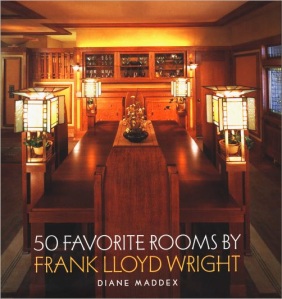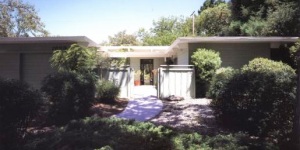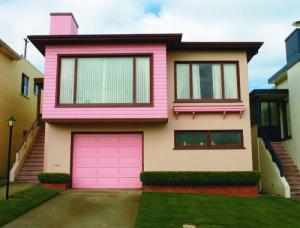Modern style in the mid-20th century
Mid-Century modern is an architectural, interior and product design form that generally describes pre- and post- second world war developments in modern design, architecture, and urban development from roughly 1933 to 1965. Mid-century architecture was a further development of Frank Lloyd Wright‘s principles of organic architecture combined with many elements reflected in the International and Bauhaus movements. Mid-century modernism, however, was much more organic in form and less formal than the International style.
Scandinavian designers and architects were very influential at this time, with a style characterized by simplicity, democratic design and natural shapes. Like many of Wright’s designs, Mid-Century architecture was frequently employed in residential structures with the goal of bringing modernism into America’s post-war suburbs. This style emphasized creating structures with ample windows and open floor-plans with the intention of opening up interior spaces and bringing the outdoors in.
Many Mid-century homes utilized then groundbreaking post and beam architectural design that eliminated bulky support walls in favor of walls seemingly made of glass. Function was as important as form in Mid-Century designs with an emphasis placed specifically on targeting the needs of the average American family. Examples of residential Mid-Century modern architecture are frequently referred to as the California Modern style. Pioneering builder and real estate developer Joseph Eichler was instrumental in bringing Mid-Century Modern architecture to subdivisions in California and select housing developments on the east coast. Eichler style, the epitome of mid-mod design Joseph Eichler was a California developer with a very particular, social vision. As millions of soldiers returned home from World War II, Eichler was determined to create a better living environment for the common man. He envisioned modern homes that incorporated various architecturally distinct elements that would appeal to the average family — and an average family income. When Eichler homes were first on the market, their average sale price was $12,000.
Eichler Homes, built over 11,000 homes in Northern California and three communities in Southern California, along with 3 homes in Chestnut Ridge NY. These homes came to be known as “Eichlers” and changed the California lifestyle. The essence of the Eichler design was inspired by Joseph’s two year stay in a home designed by Frank Lloyd Wright. He wanted to bring some of similar features from that home, such as indoor-outdoor living, to the middle class. He wanted to build homes with that open, flowing, modern style of architecture. In 1949, Joseph founded Eichler Homes, Inc. He first hired the Bay Area architecture firm of Anshen and Allen to create these affordable modern homes. The firm came up with houses that had an open plan, post and beam construction, whole walls of glass, and radiant heating. These were features you might have found in an expensive, custom-built home at the time, but certainly not in a house built for the masses. At the time, this would have been an insane concept to most developers, who would not have seen the sense and profit in hiring architects to design tract housing.
But Eichler had ideas on how to make his vision a reality. It was through careful refinement, that Eichler honed his manufacturing process. He was able to produce homes in a cost-efficient way. As in an assembly line process, he had parts constructed at a central location and then shipped to the building site. He also made use of standard building materials in a creative way. Joseph Eichler was savvy to the dawning of a new age of post-war marketing in the 50’s. He launched a sophisticated and aggressive marketing campaign to introduce his homes to the American public. For the first time in advertising history, homes were featured alongside models, posing as homeowners- looking happy and perfect in an Eichler paradise.
In today’s housing market we are inundated by such imagery. But up until then, architectural photography had been traditionally stark and cold. Eichler had his mind set on presenting these homes as fresh: warm, livable and desirable. Eichler homes seemed destined to attract niche market. Despite his efforts to appeal to the masses, the homes were never popular on a wide scale. At the time they were built, they attracted an interesting subset of people– architects, engineers, designers and modern arts lovers. Although he did not get the mainstream popularity he was aiming for, Eichler garnered a slew of awards for his work: The Life Magazine Award of Merit in 1953; the National Association of Home Builders Award in 1954; Living Magazine Award in 1955; and the American Institute of Architecture Sunset Magazine Award in 1956, 1957 and 1959. Today there is a great resurgence of interest in the Eichler home and an almost cult-like following by those who dwell in them. Eichler’s original design elements have withstood the test of time. Flat, low sloping roofs, open-plan living, the blurring of the lines between indoors and outdoors with atrium’s, window walls, skylights and sliding glass doors—these elements have an appealing and classic California modern character.
And these are just a few of the features that make Eichler homes so very popular today. Classic Eichler materials have also come back into vogue: Radiant heating, cork floors, wood paneling and vinyl tile. Of the 11,000 original Eichler’s built, many are in the San Francisco Bay Area: San Francisco, Sacramento, Marin County, the East Bay, San Mateo County, Palo Alto, Sunnyvale and San Jose. The Southern California Eichler communities are in Orange, Thousand Oaks, and Granada Hills. Recently a decision by the National Park Service has placed two Palo Alto subdivisions on the National Register of Historic Places. The 243-house Greenmeadow tract, and the 63-house Green Gables enclave, are the first subdivisions ever to be placed on the register. Eichler homes, beyond the ongoing flux in housing trends, will now have permanent historic value.
Reference:
50 Favorite Rooms By Frank Lloyd Wright
Bauhaus
Eichler: Modernism Rebuilds the American Dream
Eichler Homes: Design for Living
Little Boxes: The Architecture Of A Classic Midcentury Suburb



